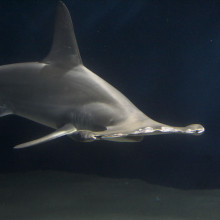in this NewsFlash, we'll be hearing about the camouflaged plant that doesn't need the Sun, a power plant that relies on osmosis and how the feeling of breath on your skin helps you to work out what sounds you're hearing. Plus, we look back to this week in Science History and the first meeting of the Royal Society.
In this episode

Plants hide too!
The animal kingdom is full of species that do their best to hide from predators by adopting all sorts of clever camouflage to help them blend with their surroundings and not get spotted. And now it seems that some plants might do something similar.
 Many plants are brightly coloured to attract pollinators or they take on the colour of the chlorophyll pigments they use to generate energy by the process of photosynthesis.
Many plants are brightly coloured to attract pollinators or they take on the colour of the chlorophyll pigments they use to generate energy by the process of photosynthesis.
Matthew Klooster from Harvard University in US and colleagues have been studying an unusual plant called *Monotropsis odorata*, which doesn't have any chlorophyll because it gets all the food it needs from mycorrhizal fungus that live in close association with their roots.
Freed from the constraints of photosynthesis, this plant has the option of adopting different colouration to suit its needs.
As Klooster and the team discovered, it seems Monotropsis odorata does its best to hide from plant-munching herbivores by covering vulnerable purple flowers and stems in brown bracts that resemble dead, brown leaf litter.
By analysing the colour of light reflected by these bracts, the researchers found that they closely match the colour of dead leaf litter.
They also found that in the wild, plants with more intact brown bracts suffered around 20% less damage from herbivores compared to plants in which bracts had been experimentally removed. Plants with more intact bracts also produced between 7 and 20% more mature fruit over the two-year study than plants with no bracts, demonstrating the major advantage that this camouflage can have on individual plants.
The odd thing is that these plants don't want to disappear altogether, because they still rely on animals paying them a visit to disperse their pollen and seeds. Klooster and the team saw bumble bees successfully finding the flowers of these plants and think perhaps the bees are lured in by a sweet scent that doesn't attract herbivores - an idea for another study to work on.
So it seems that cunning camouflage is no-longer a unique characteristic of animals, but plants can do it too.

Osmotic power plant
Osmosis is a process that is vital to the whole of life. It is based on a partially permeable membrane which will allow water through but not allow salts or other dissolved substances. If you put salty water on one side and fresh water on the other water will move through the membrane from the fresh water side to the salty one. This drives lots of processes in living cells and is the reason that soaking lettuce in water will make it swell and become more crisp.
 Now a Norwegian energy company, called Statkraft, have made use of this effect in the world's first osmosis-driven power station.
Now a Norwegian energy company, called Statkraft, have made use of this effect in the world's first osmosis-driven power station.
The principle is to put seawater on one side of a membrane and fresh water from a lake on the other. Water flows passively through the polymer membrane from the fresh to the salty side, increasing the pressure of the seawater. This pressure increase is then used to drive a turbine to generate electricity.
The current installation uses a 2000 square metre membrane capable of generating energy at the rate of 2-4 kW. This is a promising start but there are many challenges ahead including optimising the membranes so that they are not compromised by impurities in the water and in cutting costs, but Statkraft thinks that there is the potential to generate 10% of Norway's energy by osmosis, and potentially more across the rest of the world.

New gene-screen "knocks-out" pathogen targets
Scientists have discovered a quick way to flush out how pathogens like bacteria and viruses target our cells. The system could show researchers where to target their efforts in developing the next generation of antimicrobials.
 The research is presented in Science by Whitehead Institute-based scientist Jan Carette and his colleagues. The team use a human cell line called KBM7 which, unusually, contains just one copy of each chromosome (except for chromosome 8 which is present in the normal two copies). First the researchers infect these cells with viruses which insert themselves into the cells' genetic material in random places, adding a genetic marker and simultaneously inactivating the gene into which the insertion takes place.
The research is presented in Science by Whitehead Institute-based scientist Jan Carette and his colleagues. The team use a human cell line called KBM7 which, unusually, contains just one copy of each chromosome (except for chromosome 8 which is present in the normal two copies). First the researchers infect these cells with viruses which insert themselves into the cells' genetic material in random places, adding a genetic marker and simultaneously inactivating the gene into which the insertion takes place.
Next the team expose the cells to a pathogen, such as influenza. Cells that are still vulnerable to infection will succumb, leaving behind just those cells in which genes that are essential for the pathogen to gain entry or to kill the cell have been deactivated. These genes can then be tracked down by looking for the genetic marker inserted into them previously. The team show that the method can be used effectively to identify genes essential for influenza infectivity as well as the cellular targets of a range of bacterial toxins.
At the moment, comprehensive identifications of molecular targets are excrutiatingly difficult because scientists have to painstakingly unpick the biochemical pathways involved. With this tool, however, researchers will be able to deploy the molecular equivalent of a drag-net to find everything at once, helping them to spot new targets for rational drug design.

Why the strange head?
The peculiar shape of hammerhead sharks is a biological conundrum that has long puzzled scientists.
 Now American scientists have uncovered some of the secrets of these odd hammer-shaped heads, showing that having eyes spaced far apart on their wide heads lets hammerhead sharks see better than more conventionally-shaped sharks. In particular hammerheads may have enhanced depth perception, a crucial skill for predators to judge how far away prey is before swooping in for the kill.
Now American scientists have uncovered some of the secrets of these odd hammer-shaped heads, showing that having eyes spaced far apart on their wide heads lets hammerhead sharks see better than more conventionally-shaped sharks. In particular hammerheads may have enhanced depth perception, a crucial skill for predators to judge how far away prey is before swooping in for the kill.
Various ideas have been put forward over the years to explain the hammerhead sharks' extraordinary compressed and laterally expanded head, known as a cephalofoil. Possibilities include greater sensitivity to smells or the weak electric signals given off by prey animals, greater lift and manoeuvrability in the water or maybe it helps in catching and manipulating prey. But until now, few studies have tested out any of these ideas.
The research team led by Michelle McComb from Atlantic Florida University set out to test another idea which has sparked a lot of controversy among shark biologists, namely, do hammerhead sharks see better than normal sharks.
To do this the researchers mapped out the 3D visual fields of various shark species, including three hammerheads (the bonnethead, scalloped and winghead hammerhead sharks), by anaesthetising each one and using an electrode they worked out if an electrical signal is generated in the retina when a narrow beam of light is shone into the eye from a range of angles.
Of all the sharks, the hammerheads had the most overlap of vision from their two eyes in front of them - and sharks with wider heads had even more visual overlap. The team also discovered that all the shark species tested had extraordinary 3600 vision in the vertical plane - they can see all the way above and below them.
One thing hammerheads seem to be bad at is seeing what's going on behind them. There are reports of prey fish hanging behind hammerheads, perhaps hoping not to be spied.
McComb and colleagues analysed videos of sharks swimming and found that to make up for having compromised vision behind them, hammerhead sharks swing their heads from side to side to see what's going all around them.
Of course, having better vision might not be the only thing that having a hammer-shaped head might be good for. But this study unveils one of the secrets behind the evolution of these amazing animals.

13:48 - Moved by the Power of Speech
Moved by the Power of Speech
Dr Bryan Gick, University of British Columbia
Chris - We often hear that people can move you by their words that they use. Well, it turns out that that's actually physically true as well. Bryan Gick is a researcher of the University of British Columbia and he's published a paper this week showing that actually we respond to the sensation of the breath of a speaker on our skin which helps to reinforce meaning. He's with us now. Hello, Bryan.
Bryan - Hi.
Chris - Welcome to the Naked Scientists. Do tell us what have you been doing?
 Bryan - Well, we've just been aiming puffs of air at people basically and seeing how that affects their speech perception.
Bryan - Well, we've just been aiming puffs of air at people basically and seeing how that affects their speech perception.
Chris - So talk us through the experiment, what did you actually do?
Bryan - Well, initially, we thought that there are certain things that we can pick up in our environment that help us to perceive speech. And we haven't had so much insight into how the tactile sense works into this.
Chris - So, in another words, we know that we're comfortable with the fact that people lip read, for example, and so they help their comprehension of what someone is saying by following the movements of someone's lips. But there's an additional dimension to this which is the air coming out of their mouth.
Bryan - Exactly. And we aren't particularly fond of the air approach, it just happens that the air approach is the best way to get at what kind of information could somebody be conveying, that you can just sort of passively pick up from your environment.
Chris - So how did you do this?
Bryan - So we thought about these little puffs of air that people produce when you say a sound like "pah". If you put your hand in front of your face, if you're an English speaker, you can feel a little puff of air in your hand. And if you say "bah" you don't really feel a puff of air. So we took little tiny puffs of air and put them on different places on people's bodies, and at the same time we played sounds that they could hear through headphones.
We found that if you if you play the sound "bah" to someone and at the same time, somewhere on the body, they feel a little gentle puff of air that's inaudible to them, they'll experience the sense of having heard "pah".
Chris - Alright. So you can completely throw them off the scent and you can make them think they're hearing a different sound because you're pairing a puff of air which they would normally associate with hearing the "pah" sound and in fact you played them a "buh"sound.
Bryan - You're right. So, a B will sound like a P, a D will sound like a T and so on. And this is interesting to us, not just because it draws up your perception, but it suggests something, I think, bigger which is that we really seem to take all the information around us from whatever sense modality is available and we incorporate it into percepts of the world.
Chris - Does it matter where on the person's body you give the puff of air when doing this experiment?
Bryan - It doesn't seem to matter. In the Nature paper, we looked at puffs of air on the neck and the hand and in other studies that we haven't published yet, we looked at the ankle, for example, and we get the same effect anywhere.
Chris - So in other words, the brain is pretty clever in that it's integrating information coming in from all over the place to reinforce the information that would be coming in just from the spoken language?
Bryan - Exactly. And it sort of challenges this traditional idea that you see with your eyes and that gets processed by a particular part of your brain and you hear with your ears and that gets processed by another part of your brain. It looks like our brains just perceive things and take everything in.
Chris - And obviously, people who talk on the radio or listen to a podcast, TV programmes, they have no problem interpreting what people are saying. So when would the body want to use this additional dimension of comprehension?
Bryan - Well, the way I view it, we're biological parts of our environment and we, like everything, like the plants without chlorophyll, we use whatever we've got to get by. And in our particular case, if we happen to only have one sense modality available to us, we'll get by. If however we've got all of our senses and they can pick up information from our environment, we'll use it all and we'll do it seamlessly.
Chris - So I guess that puts a whole new spin on the meaning "breathing down in someone's neck," doesn't it?
Bryan - Yes, it does.
Chris - Bryan, thank you very much. That's Dr. Bryan Gick, who's a researcher at the University of British Columbia, paper in Nature this week, explaining how puffs of air can actually distort our perception of what people are saying.

18:27 - This Week in Science History - The Royal Society
This Week in Science History - The Royal Society
Sarah Castor-Perry
This week in Science History saw on the 28th of November 1660, the first meeting of the Royal Society, the oldest continuously running Academy for Sciences in the world.
 The beginnings of the Royal Society lie in the 1640s, when an 'invisible college' of thinkers and philosophers began meeting to discuss natural philosophy of the time. On the 28th of November 1660, 12 of them including Christopher Wren, Robert Boyle and Sir Robert Moray held their first official meeting at Gresham College in London. After several changes of home over the years, including an emergency move after the Great Fire of London in 1666, the society is now based in Carlton House Terrace in central London.
The beginnings of the Royal Society lie in the 1640s, when an 'invisible college' of thinkers and philosophers began meeting to discuss natural philosophy of the time. On the 28th of November 1660, 12 of them including Christopher Wren, Robert Boyle and Sir Robert Moray held their first official meeting at Gresham College in London. After several changes of home over the years, including an emergency move after the Great Fire of London in 1666, the society is now based in Carlton House Terrace in central London.
The first use of the name the Royal Society came in 1661 and the second Royal Charter of 1663 refers to it as the Royal Society of London for Improving Natural Knowledge. King Charles II himself expressed a wish to become a fellow of the society. A shift in the selection process for fellows came in 1847, when it was decided that fellows would be elected purely on the basis of their scientific prowess and body of work, whereas before, wealthy enthusiasts who weren't necessarily scientists were allowed to become fellows in the hope that they would become patrons of other members.
 Fellows of the Royal Society over the years have included some of the most famous scientists in the world like Sir Isaac Newton, Charles Darwin, Ernest Rutherford, Albert Einstein, Francis Crick & James Watson and Stephen Hawking.
Fellows of the Royal Society over the years have included some of the most famous scientists in the world like Sir Isaac Newton, Charles Darwin, Ernest Rutherford, Albert Einstein, Francis Crick & James Watson and Stephen Hawking.
Since 1661, the society has been publishing books and academic journals, with Proceedings of the Royal Society being one of the most prestigious journals to be published in. Series A covers physics, maths and engineering, and Series B covers biology. It also publishes several other journals, including Philosophical Transactions, which has been in print since 1665, making it the longest running scientific journal in the world.
The Society also acts as an impartial adviser on science to policy makers, and despite advising the UK government on current scientific issues (that today include things like GM foods and low carbon energy sources), it is independent from the government. The Society's motto, given in 1663, is 'nullius in verba', which roughly translates as 'take noone's word for it' - expressing the Society's belief in the importance of empirical, experimental proof and an unwillingness to bow to external authority.
Since 2005 the astrophysicist Lord Martin Rees has been President of the society. He is also the astronomer Royal, and Master of Trinity College Cambridge.
In 2010, the Society will celebrate its 350th anniversary, and there will be events across the UK to get people involved in science, including a huge science festival on the South Bank in London. During those last 350 years, The Royal Society has been celebrating important and visionary scientists, supporting emerging talent and inspiring children about science and maths. Its history is closely linked with the history of science as a whole, and hopefully we can look forward to at least another 350 years of successful patronage, education and inspiration.










Comments
Add a comment